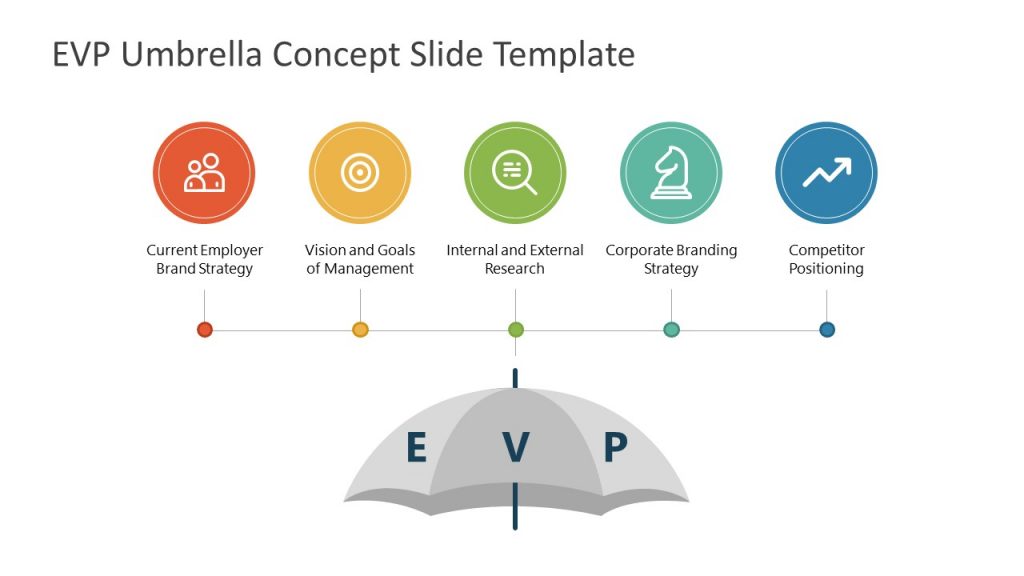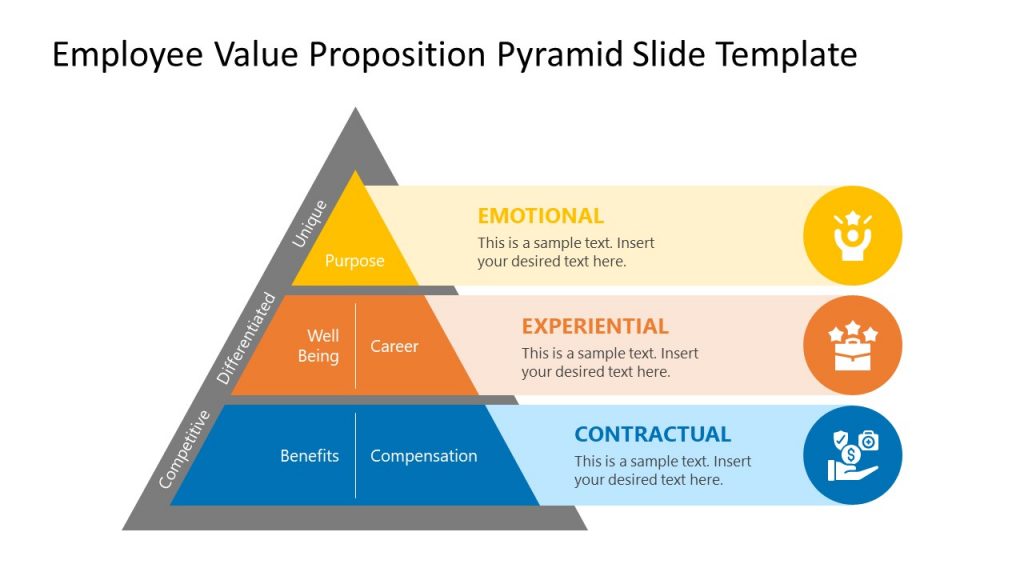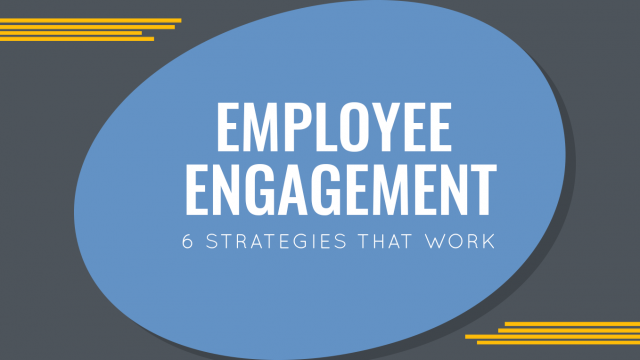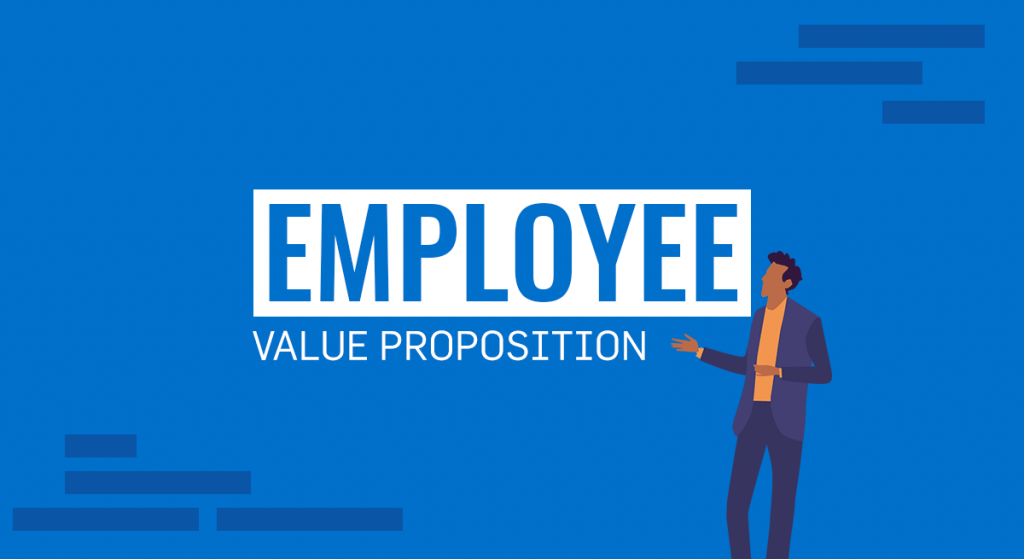
People searching for a job might want to work for certain employers due to their repute as an organization that offers attractive employee benefits. Acquiring a job in such an organization is deemed not only beneficial in financial terms but people might also feel a sense of pride working for an employer that is known to value its employees. This also means that the most competitive people in the workforce would be competing to get employed by such an employer due to their employee value proposition.
Table of Content
- What is an Employee Value Proposition (EVP)?
- What’s the difference between your EVP and your employer brand?
- What does Employee Value Proposition stand for? (Key Components of a Great EVP)
- Why do you need an employee value proposition (EVP)?
- 8 Steps to Formulate a Strong Employee Value Proposition
- Employee Value Proposition examples
- Employee Value Proposition in the Era of COVID-19 and Beyond
- EVP Frequently Asked Questions
- Final Words
What is an Employee Value Proposition (EVP)?
Employee Value Proposition (EVP) or What EVP stands for is similar to the concept of employer branding, employee value proposition refers to how organizations are able to attract skilled employees in a competitive job market through the corporate culture, and benefits offered by them. Such organizations market themselves in a way that people aspire to work for them, making it possible for the organization to employ and retain skilled and talented employees from the workforce.
What is the employee value proposition? It’s a vital tool in defining the unique benefits and experiences that set an employer apart from the rest. The benefits offered by an organization can result in a more productive workforce with more job satisfaction compared to others in the market. This can also help the company build a positive image before its consumers, who might value the company because of the value it is perceived to give to its employees.
What’s the difference between your EVP and your employer brand?
Employee Value Proposition (EVP) and employer brand are closely related concepts in the realm of talent acquisition and management, each serving distinct roles within an organization. EVP, primarily an inward-facing concept, focuses on what an organization offers its employees in exchange for their skills and contributions. It delineates specific benefits such as compensation, work-life balance, career growth, and the work environment, providing a clear answer to the question, “What’s in it for me as an employee?” Importantly, EVP is customizable and serves as the foundation for attracting, engaging, and retaining talent.
On the other hand, the employer brand is an outward-facing concept, representing how the organization is perceived by external stakeholders, including job seekers, customers, and investors. It encompasses the entire perception of the organization as an employer, including its culture, values, reputation, and the overall experience of interacting with the company. Employer brand is influenced by EVP as it encapsulates the core elements of the employee experience that contribute to the organization’s reputation as an employer. In essence, EVP details what employees receive, while the employer brand shapes the broader reputation and identity of the organization as an employer in the external marketplace. Together, they form a powerful combination for attracting and retaining talent while building a positive organizational image.
What does Employee Value Proposition stand for? (Key Components of a Great EVP)
For an organization to be successful in attracting the most skilled employees from the market, it needs to have an employee value proposition that can help create an environment where people aspire to work for it. Similar to aspirational buyers who look to buy expensive products that are perceived to add to their prestige.
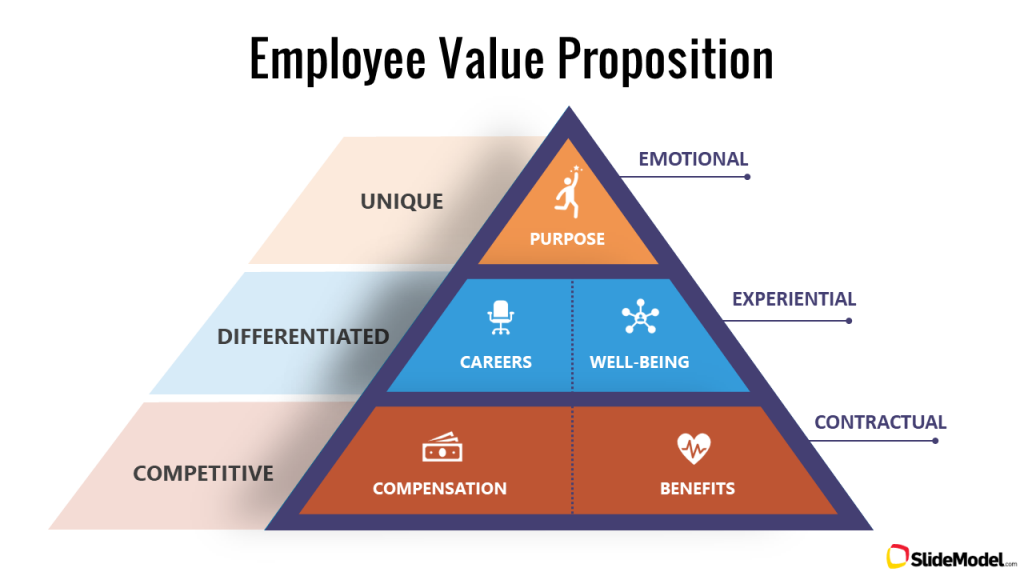
Many people dream of working for tech giants like Microsoft, Google, or IBM. Working for these companies is not only considered a good career option but is also considered a matter of prestige for employees. Hence, there are many key components of a great EVP.
Financial Benefits
Companies with the best EVP often offer one of the most competitive financial benefits. These include not only the salary of the employee but also other benefits such as the potential to acquire company stocks, bonuses, etc. It is recommended nowadays to create pay stubs for employees as it is useful to show the incomes of workers, especially for those who are filing their tax returns.
Fringe Benefits
Other than salary, bonuses, and company stocks, organizations also offer different fringe benefits. These include paid leaves, health insurance, provident fund, the option to acquire discounts on company products or services, and even fully paid vacations to dream holiday destinations. Some of the fringe benefits offered by companies might be provided to top employees annually. Whereas other factors such as seniority and the years spent in an organization might also lead to increased benefits.
Job Security
Many people might be risk-averse and look for jobs that are stable and provide job security, whereas others might look for better-paid jobs. However, the value of job security cannot be discounted when considering EVP. This is because a stable job can help alleviate employee stress, whereas uncertainty in the extension of contracts or the potential of being fired due to trivial reasons can result in an environment that might repel skilled individuals from working for the organization.

Potential for Career Growth
An employee often needs more than just financial benefits. With time, people also aspire to climb up the career ladder and aim to get designations that might make them feel accomplished in their careers. Some employees might even opt for a lower-paid job just because they get the opportunity to work at a larger scale or have a better designation. For example, a sales representative who might be stuck at the same designation for a decade might deem it to be too long, regardless of financial benefits. He/she might want to climb up the career ladder to enjoy the prestige and sense of accomplishment that comes with it. Not to mention it can be a matter of pride for some people who fail to climb the career ladder since their peers, relatives, and friends might start considering them as mediocre or incapable.
Working Environment
A company might offer a great salary and other financial benefits but how long can you work for an employer that might be too demanding, with a toxic working environment? Employees can get burned out and even suffer from physical and psychological issues because of a demanding working environment that does not value the welfare of the employee.
A Gallup poll in 2021 concluded that 57% of U.S. and Canadian workers felt stressed on a daily basis. The majority of these workers included women (62%) and more than half of the men (52%) that took part in the survey. It is not just important for an organization to look after the well-being of their employees using existing mechanisms but also to adapt company policy according to need. A good example of this is the COVID-19 pandemic, which has added to the stress of the global workforce.
Corporate Culture
Would you work for a company that might offer a great salary package, and fringe benefits, and look after the welfare of its employees but has a corporate culture that might encourage environmental degradation and malpractice? While some people might consider financial benefits above other considerations, not everyone is willing to work in an environment that might not fit with their sense of morals.
The corporate culture of an organization consists of many aspects including beliefs and behaviors that form the relationship between the management and employees. Hence, the corporate culture of an organization can be a major factor affecting its employee value proposition.
Job Satisfaction
Some people stick to a job for their entire career, whereas others frequently or periodically switch jobs. Job satisfaction is a major factor that can enable retaining existing employees and attract skilled workers from the job market.
Companies that look after the well-being of their employees also try to make the working environment more attractive, so they feel passionate about their job and improve employee engagement. Someone delivering PowerPoint presentations on a daily basis might get bored of their job unless there is job rotation, the scope for innovation, or benefits that can outweigh the boredom. This is especially true for skilled individuals working for large organizations. People who might not be pinned down by mere financial considerations.
The above-mentioned list of factors plays a major role in job satisfaction, such as job stability, financial and fringe benefits, the scope for maintaining a healthy work-life balance, etc.
Why do you need an employee value proposition (EVP)?
In today’s competitive job market, where top talent is in high demand, having a well-defined Employee Value Proposition (EVP), or understanding what is the purpose of a value proposition, is no longer just an option—it’s a strategic necessity for organizations of all sizes and industries. An EVP serves as the foundation upon which your employer brand is built, and it plays a crucial role in attracting, engaging, and retaining the right talent. Here are compelling reasons why your organization needs a robust EVP:
Attracting Top Talent: In a talent-driven economy, the best candidates have choices. A strong EVP sets your organization apart, making it more appealing to highly skilled professionals who are actively seeking opportunities. It allows you to compete effectively for the top talent in your industry.
Retaining Key Employees: Your EVP isn’t just about attracting new hires; it’s equally important for retaining your existing workforce. Employees who feel valued and engaged are more likely to stay with your organization, reducing turnover and the associated costs.
Employee Engagement: A well-crafted EVP resonates with employees on a personal level. It helps to create a sense of belonging and purpose within the workplace, boosting employee morale, motivation, and engagement. Engaged employees are more productive and committed to the success of the organization.
Alignment with Company Culture: Your EVP should align with your organization’s values, mission, and culture. When employees see that their personal values align with those of the company, it fosters a strong sense of identity and commitment to the organization’s goals.
Cost Savings: An effective EVP can lead to cost savings in various ways. It can reduce recruitment costs by attracting candidates who are more likely to be a cultural fit and stay with the company. Moreover, engaged employees are often more productive, reducing the costs associated with absenteeism and turnover.
Enhanced Reputation: A positive EVP can enhance your company’s reputation as an employer. It not only attracts top talent but also positions your organization as an employer of choice within your industry. A strong reputation can lead to a larger pool of qualified candidates and more opportunities for business growth.
Increased Innovation: Engaged and satisfied employees are more likely to contribute innovative ideas and solutions to your organization’s challenges. A compelling EVP can create an environment where employees feel encouraged to bring their creativity and talents to the table.
Adaptability to Change: In a rapidly changing business landscape, organizations must be agile and adaptable. An EVP that promotes a culture of learning, growth, and flexibility can help employees embrace change and navigate uncertainties more effectively.
Legal Compliance: A well-defined EVP can also assist in ensuring legal compliance, particularly in areas related to compensation, benefits, and equal opportunity. It can help organizations avoid potential legal issues and disputes.
Long-Term Sustainability: An EVP isn’t just about short-term gains; it contributes to the long-term sustainability of your organization. By consistently delivering on the promises made through your EVP, you build trust and loyalty among employees, creating a stable and resilient workforce.
8 Steps to Formulate a Strong Employee Value Proposition
Formulating an employee value proposition requires an organization to be clear in the goals it aims to achieve through its workforce, the values, and beliefs it stands for, and how these affect its employees. Creating an employee value proposition is a critical step in attracting and retaining top talent, as it defines what employees can expect from their experience with your company. If you are looking to formulate or reorient your employee value proposition, here are a few steps that can guide you through the process.
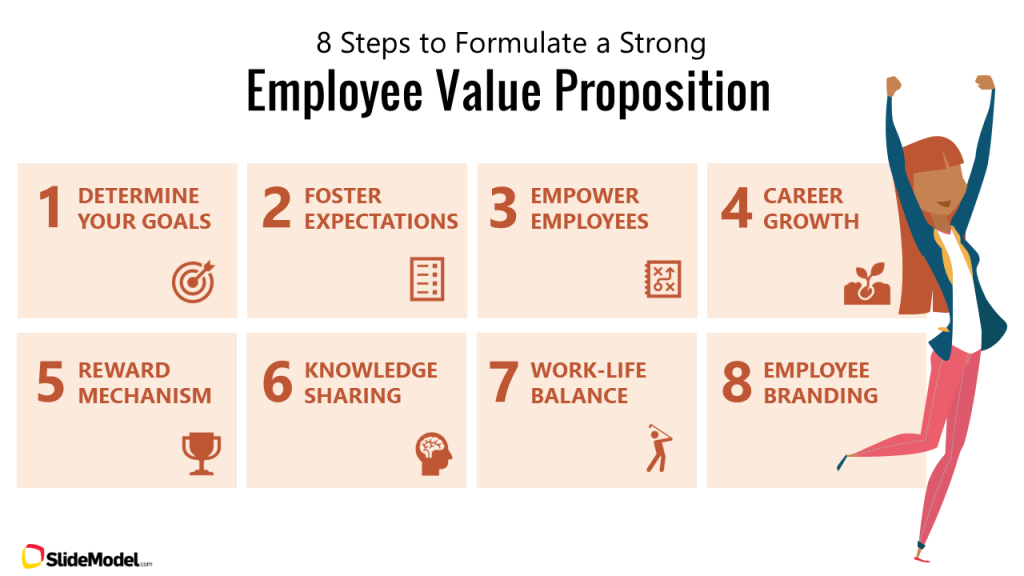
1. Determine Your Goals
It is important for an organization to be clear about the goals it aims to achieve through its employees. These goals should be aligned with everything from the job description of an employee to the benefits attached to the job.
Companies like Google provide employees with an environment that fosters innovation and encourages employees to spend time on company-funded side projects. The benefits offered by the company align with its goals, making it one of the biggest tech companies in the world.
2. Foster Realistic Expectations
A company that might cut down on promised benefits for employees might result in creating a negative perception of itself. Where employees might feel cheated and not given their due share after the end of a quarter or financial year. It is important for organizations to foster realistic expectations and not create unrealistic expectations that it might not be able to live up to.
When Jeff Bezos started Amazon as an online retailer back in the 90s, he encouraged employees to work hard to take the company forward to reap the benefits of its potential success. The concept he instilled in employees fostered realistic expectations, where the employees aimed to benefit in case the company experienced growth. Over the years Amazon has fostered an environment where it claims to be the best place for innovators.
3. Empower Employees
Micromanagement can be the bane of most organizations. Skilled employees like to work with a bit of breathing space where they can foster their talents to help the organization grow and achieve desired goals. However, a working environment that is deemed congested can scare away competent employees.
4. Career Growth
One of the most attractive non-financial benefits for employees is often the chance for career growth. Organizations that are deemed to stagnate employees are not considered attractive enough by potential employees.
5. Create a Fair Reward Mechanism
While it’s hard and quite arbitrary to define a ‘fair’ reward mechanism in an organization, some of the basics for creating such a system aren’t that hard. An organization that values hard-working employees, and innovation, and avoids nepotism is likely to have less employee resentment or dissatisfaction. Unfairly rewarding employees or snubbing skilled workers with bosses falling victim to the Peter Principle is likely to result in the organization losing some of its best employees.
6. Encourage Knowledge Sharing
Employees who are able to benefit from an organization’s knowledge feel less bewildered at the workplace. This also encourages departments to mingle and not work in silos. By encouraging a culture of knowledge sharing, the organization can offer an additional benefit to employees, i.e. the ability to learn and grow their skills through the learnings of the organization.
7. Encourage Work-Life Balance
While some organizations with a cutthroat corporate culture might be deemed attractive due to the constant push they offer to help raise the bar for employees, a work-life balance is essential to avoid burnout. Gone are the days when a working environment with nerve-wracking competitiveness would be deemed acceptable by the modern corporate workforce. Steve Jobs in his early years was often criticized for fostering such an environment at Apple, which eventually led to employee resentment. For this reason, he is now known for titles such as a ‘great and toxic leader’.
8. Invest in Employer Branding
By investing in a positive image of the organization as an employer that takes care of its employees, you can not only attract talented employees but also benefit from the customer goodwill that comes with it. Through advertisement and by making your employees your ambassadors, you can foster an environment that makes your company stand out and become an organization where people would aspire to work.
Employee Value Proposition examples
To learn from the top companies in the world, let’s take a brief look at their Employee Value Proposition examples and what makes them attractive to people who aspire to work for them.
Google’s Employee Value Proposition
Google is a tech company that not only has a history of fostering innovation but also attracts employees by offering benefits that are not just limited to the employee. Its famous 20% project provided employees with 20% of paid job time to work on personal projects that have helped create projects like Gmail, Google AdSense, Google News, etc.
Google claims to provide a ‘world-class benefits experience’ for employees (Googlers) and their loved ones. Looking after their physical, psychological, and financial well-being. Other than financial and fringe benefits, Google also advertises itself as an organization offering flexibility and time off to help employees recharge and relax. Furthermore, Google has a set of extensive benefits for the families of its employees.
Amazon’s Employee Value Proposition
Over the years, Amazon has established a repute for being a great place for innovators to explore their potential. Among the things that Amazon enlists on its website as one of the ‘best companies to work for innovators’ includes its policy of customer obsession, passion for invention, investment for long-term continuity, empowering innovators, embracing failure, and fostering creativity.
While Amazon was once deemed a great organization to work for, its reputation has taken a hit in recent years due to various scandals associated with employees complaining about bad working conditions. This was also the cause for the temporary closure of Amazon warehouses due to a court order in France during the early days of the COVID-19 pandemic.
Netflix’s Employee Value Proposition
Netflix claims to offer an environment with ‘freedom and responsibility’. This is a good example of managing expectations while also providing an attractive tagline for employer branding. A few key elements of Netflix’s EVP include offering employees the freedom to make decisions, be candid, share information, avoid rules, etc.
Netflix does not add too many sugar-coated themes to its EVP. It aims to attract and foster skilled employees to create a workforce where only the most competitive individuals are meant to survive and hold employees accountable.
A glance at the Netflix jobs page will give you the impression that the company does not believe in micromanaging employees, while also maintaining a strict code for holding people responsible for their actions. People with a strong sense of duty might find such a working environment quite attractive.
Apple’s Employee Value Proposition
Over the years, Apple has been often criticized for the corporate culture fostered by Steve Jobs. Apple’s EVP appears to encourage everything that is likely to attract Millennials or Generation Z. The most prominent aspects of Apple’s Employee Value Proposition example are also modern cliches, including claims about diversity, inclusion, racial equity, etc. Perhaps the reason for this has been the employee unrest at Apple in recent years with claims of harassment and discrimination that have rocked the company.
While Apple might be one of the biggest companies in the world, some would argue that its EVP still leaves a lot to be desired. However, Apple still appears to be attractive to people because of its standing as a tech giant and the conventional benefits one would expect by working for such a company. This is because Apple still stands as a company that offers good financial benefits, the scope for career growth, and the uplift it can offer people’s careers by having Apple on their resume.
Nike’s Employee Value Proposition
Much like Google, Nike’s EVP consists of a focus on taking care of its employees and their families through various benefits offered by the company. Nike instills a sense of family among its employees. Making them feel like a part of a family unit instead of a working hand. The focus of Nike’s EVP, other than financial and healthcare benefits includes fitness opportunities discounts, and advanced learning opportunities.
Spotify’s Employee Value Proposition
Among the employee value proposition examples from large organizations, Spotify’s EVP aims at attracting people it deems as a good fit for the job. Spotify encourages innovation and company growth by encouraging employees to enjoy their time at the workplace. Some of the benefits that stand out for Spotify include the utility for employees to explore learning opportunities, flexible public holidays where people can swap days off according to their values and beliefs, and flexible share incentives to help employees acquire company shares.
Employee Value Proposition in the Era of COVID-19 and Beyond
In the wake of the COVID-19 pandemic, many companies are now offering employees the opportunity to work- from home or are adapting to a hybrid model. A few examples include Facebook, Microsoft, Amazon, and Twitter. There is also discussion to switch to a permanent work-from-home model for companies, at least for certain types of jobs.
The work-from-home model has taught many people to see the perks of avoiding peak rush hours, not skipping breakfasts, or avoiding the stress of long commutes. As many employees now find it easy to wake up a bit late, since they don’t have to spend time in commute, take their breakfast to the table as they work on their laptops, and spend more time with family. Many people can also benefit from living in cheaper cities instead of spending a hefty amount on rent in big cities where many attractive job opportunities usually lie. This has changed the landscape for hiring workers as many companies like McDonald’s are finding it hard to hire waiters due to people moving away from the industry in search of something different.
EVP Frequently Asked Questions
How do you differentiate your Employee Value Proposition?
Differentiating your EVP from other companies is a fundamental factor in attracting the best human talent to your company. To achieve this, one of the most effective techniques is to use a SWOT Template. Through SWOT Analysis you will be able to identify the strengths, opportunities, threats, and weaknesses of your value proposition and find areas for improvement.
How to effectively communicate your Employee Value Proposition?
The first step is to involve your employees in the EVP creation process. In this way, they will feel able to give their opinion and recommend and promote good practices for effective EVP creation. At the same time, generating a communication strategy through social networks is a smart way to communicate an efficient EVP. We recommend using the Employee Value Proposition Presentation to communicate it in a professional format.
How is an Employee Value Proposition measured?
Some of the quantitative metrics to measure an effective EVP are the number of new people interested in working in the company, the number of interviews conducted since the implementation of the EVP, the number of new employees, and employee retention time in the company.
Final Words
With the changing landscape of the job market, the EVP of organizations will have to adjust to widespread change. Be it work-from-home initiatives, an emphasis on work-life balance, or encouraging equality and diversity at the workplace. The modern workforce, now no longer dominated by baby boomers, does not encourage the same values as the old guard. People today aren’t just looking for financial perks but also a workplace that resonates with their values. The prospect of working a 9-5 job until old age is no longer attractive.
We can argue that the modern workforce is also more engaged due to digital technology, with shorter attention spans and quicker energy drains due to digital screens affecting the way people work and interact. This means that the employee value proposition, particularly pitched by market leaders will have to offer more than financial benefits to attract the best in the business. It’s a delicate balance between financial and physical well-being while maintaining an environment that encourages diversity, inclusion, and dignity for its workforce. This also creates the dilemma of companies being unable to please all segments of the workforce while looking to avoid hefty lawsuits and bad press due to a cutthroat corporate culture.
